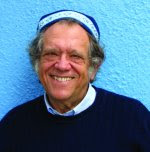Chapter one of Breshit presents an account of creation that provides the ontological foundation for human rights. God creates human beings in the divine image. And having done so, God proclaims that the entire creation is “very good.”
The great Hasidic teacher the Kedushat Levi, riffing on the line in the morning prayer “yotzer or u’voreh choshech” (Who creates light and shapes darkness—in the present tense), points to creation as an ongoing process. This interpretation provided one of the foundations for my teacher Abraham Joshua Heschel to say that human beings are potentially partners with God in the healing and transformation of the world (tikkun olam), because the creation is not yet finished. We are here in part to do what we can, enabled by being created b’tzelem (in the image).
This same first chapter of the bible tells us that the first adam (human being) was created male and female. Unfortunately, subsequent human beings have not maintained this balance between male and female energies, and in the last ten thousand years patriarchal and class dominated societies have privileged male power over female nurturing. One remnant of this important aspect of life is the divine name El Shadai–the nurturing, breasted God, according to one reading (shadayim are breasts in Hebrew); the God that “is enough,” from the Hebrew word dai, in another reading. Of course, our first experience of “enoughness” is at our mother’s breast.
If there is one powerful imperative for human life today, and the necessary prerequisite for any environmental strategy to work, it is to return to that sense of “enoughness” so that we stop acting as though unlimited growth and accumulation of more things is a reasonable goal. This imperative of expansion built into the logic of the capitalist system has already strained the planet’s capacity to or past the breaking point. A first start in this direction would be to reclaim that balance between male and female energy described in Gensis I and now sorely lacking in the most powerful forces shaping society today.
But of course, Genesis I is not the only creation story, and the next one, beginning in Genesis II, can be read as reflecting a very different sensibility, one in which masculine energies are dominant. Not a surprise, if we understand the Torah as a document which reflects both the revolutionary sensibilities of a people reveling in their liberation from slavery and the despair of a people that has witnessed the triumph of evil, in the form of Babylonian conquest and destruction of the Temple. This dual vision has been with humans since the emergence of class societies. One worldview sees human beings as thrown alone into a hostile world, in which others will seek to manipulate and dominate us in order to maximize their own well-being and safety (and hence our only path to well-being or “homeland security” lies in dominating others before they dominate us first). This is the post-Temple-destruction worldview, which gained a lasting role in subsequent tradition after Hellenistic culture and the ruthlessness of Greek and Roman rule seemed so permanent that to doubt meanness and cruelty seemed “unrealistic.” That worldview became dominant in post-Holocaust Jewish sensibility, and many Israelis today have a kind of pathological fear of being seen as a “fryar”—someone who naively trusts in the goodness and decency of others.
The other worldview grows from being nurtured as a baby by a mother who gave us love freely as her milk flowed to us—in midrash, as God fed the Israelites in the desert. That experience teaches us that safety and “homeland security” may come from building loving, caring and generosity-based relationships with “the other” (who is, like us, also created “in the image”). And this forms the foundation for what I call a Judaism of Love that rejects the “realists” and insists that belief in God is in part acting as though the world can in fact be based on generosity and caring for others, and that the fear-oriented Judaism is a product of post-traumatic-stress disorder that needs to be healed.
Since both worldviews persist in almost every human being on the planet, the key question facing us is not “which is really true,” but rather which one do we choose to make more true in the way that we treat “the other” (ha’ger, Hagar, the immigrant, the homeless, the powerless). In the middle of Succot, which reminds us that we ourselves were once the homeless and the powerless, Jewish consciousness might have some propensity to align with the worldview of the nurturing, loving energy of the universe. But having been brutalized and traumatized for many centuries, we may not be surprised that so many of our people embraced the brutality of this past summer’s Israeli assault on Gaza because “there is no alternative.” The Torah has both voices running through its text, Let us hope, as we enter the New Year and begin our sacred story anew, that we find ways to strengthen our people’s capacity to reclaim the hopeful and generous spirit of Genesis One and its powerful embrace of the goodness of all humanity.
Rabbi Michael Lerner is editor of Tikkun: A Jewish and Interfaith Critique of Poltiics, Culture and Society www.tikkun.org and author of eleven books including Jewish Renewal: A Path to Healing and Transformation, The Socialism of Fools: Anti-Semitism on the Left, and Embracing Israel/Palestine available at www.tikkun.org/eip). He welcomes comments: rabbilerner.tikkun@gmail.com

